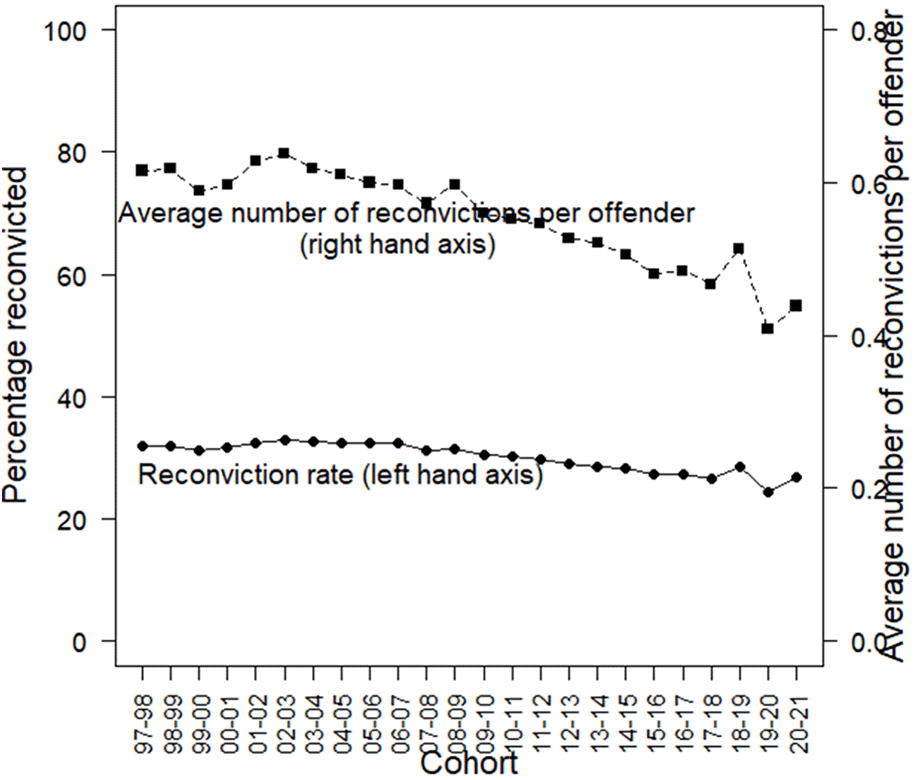Reconviction Rates in Scotland: 2020-21 Offender Cohort
Statistics on reconvictions are presented up to the latest cohort of 2020-21. The latest year’s data is impacted by the COVID-19 pandemic and should not be interpreted to be indicative of longer term trends.
2. Key Points
- The reconviction rate increased by 2.6 percentage points over the last year from 24.3% in 2019-20 to 26.9% in 2020-21. The average number of reconvictions per offender increased by 8% in the same period from 0.41 to 0.44 (Table 1).
- From the people who have offended in 2021-22, 34% did so for the first time in at least 10 years, up from 31% from the previous year.
- After last year’s COVID-19 impacted decrease, the increase in the reconviction rate and average number of reconvictions per offender still remains at one of the lowest levels recorded. The most recent figures are still lower than those ten years ago. Between 2011-12 and 2020-21, the reconviction rate has fallen by 2.8 percentage points from 29.6% to 26.9%, and the average number of reconvictions per offender has decreased by 20% from 0.55 to 0.44. (Table 1).
- Males are reconvicted more often, on average, than females. In 2020-21, the average number of reconvictions per offender for males was 0.45, which was 16% higher than the value of 0.39 for females (Table 2).
- As in previous years, offenders who committed a crime of dishonesty had the highest reconviction rate (40.7 in 2020-21), compared to offenders that committed another type of crime. Offenders who committed a sexual crime had the lowest (8.8% in 2020-21) (Table 6).
- 5.4% of offenders with an index domestic abuse crime or offence in 2020-21 were reconvicted for a further domestic abuse crime or offence (Table 8a), and 17.0% were reconvicted for any crime or offence.
- Offenders released from a custodial sentence had an average number of reconvictions per offender of 0.66 in 2020-21, which was 5% lower than 0.70 in 2019-20 (Table 9). Of those convicted in 2021-22 with a custodial sentence, 70.0% had at least one previous custodial sentence in the past 10 years, with 35.7% having between 3 to 10 and 12.9% having over 10.
- Short custodial sentences have higher reconvictions than longer sentences. This is largely because offenders who are given shorter sentences commit relatively less serious crimes, and tend to commit more of these crimes than those committing more serious crimes. Therefore, they are reconvicted more often. In 2020-21 the average number of reconvictions per offender for custodial sentences of three months or less was 0.96, compared to 0.08 for those over four years (Table 10a).
- Community Payback Orders (CPOs) are the most commonly used community sentence. The reconviction rate was 27.9% in 2020-21, an increase from 25.4% in 2019-20. Of those convicted in 2021-22 with a community sentence, 49.5% had at least one previous community sentence in the past 10 years, with 18.6% having between 3 to 10 and 0.8% having over 10. The cohort size for CPOs had a large decrease from the previous year, down by nearly half (Table 9).
- 16% of individuals given a non-court disposal by the police in 2020-21 (such as a warning or fine) received another non-court disposal within a year (Table 19).

Contact
Email: Justice_Analysts@gov.scot
There is a problem
Thanks for your feedback